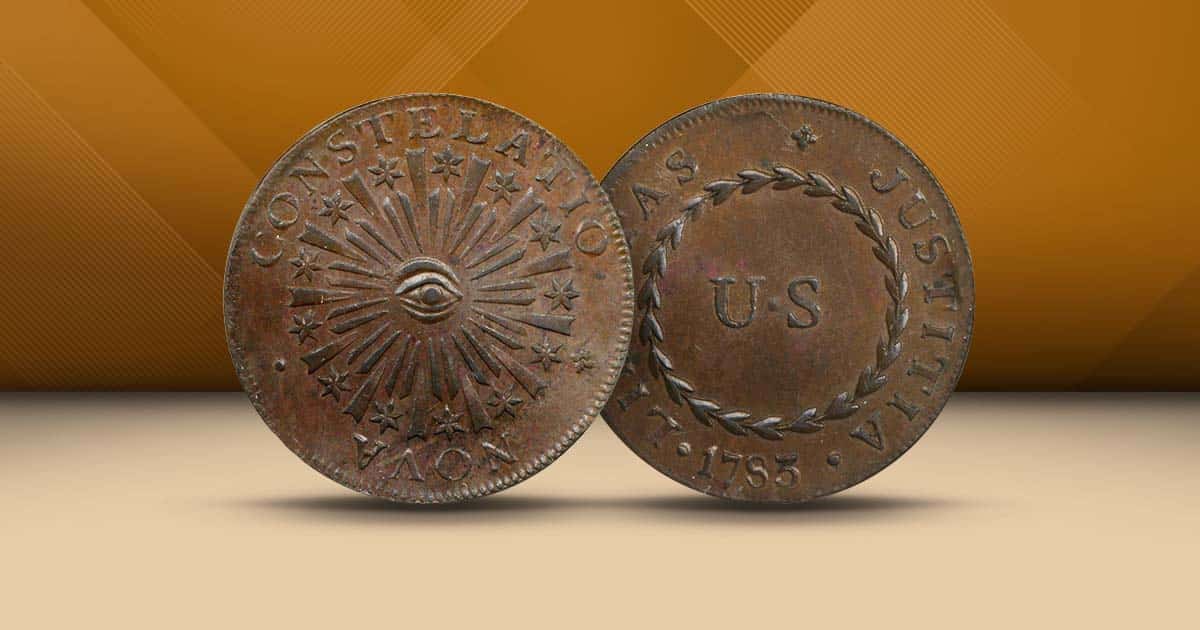
The Seven Varieties of 1783–1786 Nova Constellatio Coppers
In 1783, Robert Morris, on behalf of the Continental Congress of the United States, employed a British engraver, Benjamin Dudley, to create a set of American coins for national usage. The coins designed were actually silver patterns and were not denominated in Dollars but in “Units.” There were 100, 500 and 1,000 units of Silver pattern coins along with 5 units struck in copper. Because they were patterns they were struck in very limited numbers to show those making the coinage decisions what they would look like as real coinage.
The obverse of all of the patterns displayed the Eye of Providence in the center. Rays were emanating from the eye and thirteen stars were interspersed between the rays. Around the periphery was the Latin phrase “NOVA CONSTELLATIO,” meaning a “New Constellation.”
The reverse of these pattern coins displayed a wreath within the letter US in the script. A denomination was inscribed on these pattern coins. Around the reverse periphery was another Latin phrase, “LIBERTAS JUSTITIA” translated to ”Liberty and Justice.” The date was displayed at the bottom of the reverse.
From those patterns, it is believed, that these Nova Constellation copper coins were born. The copper coins, primarily dated 1783 and 1785, with a rare variety dated 1786 were struck in fairly large quantities in Birmingham, England. The coins were later shipped to the colony of New York where they did circulate as there was a coin shortage.
There are at least seven major types of Nova Constellatio coppers. Many have differences in the word order, some various types of rays with blunt or pointed rays, and still others with a small or a large ‘US’ in the script.

One of the first issues is a 1783-dated Nova Constellatio copper, with pointed rays and the small US, not in script.

A different variety of 1783–dated Nova Constellation coin is the coin also has pointed rays but a large “US”.

The final 1783-dated variety has what are considered to be blunt rays, which are quite different from the pointed rays.

Coins dated 1785, also comprise the last of the more common Nova Constellatio copper coinage. There are three major types here as well. There is a dated coin that is an incorrect spelling of “Constellatio” with blunt rays.

The next type of 1785 coin, is one where “CONSTELLATIO” is spelled correctly and the copper coin has blunt rays.

The last variety dated 1785 is a Nova Constellatio copper where Constellatio is correctly spelled and has a small, close date.


The dates on these coins do not mean that was the year of minting. The 1783-dated coins were put into circulation in America sometime in 1785 – 1786. The rarity of the 1786-dated coins is proven in that only approximately 15 specimens are known.
| Date | Type | Mintage | VG Value | AU Value |
| 1783 | Pointed Rays, Small US | Unknown | $125 | $1,500 |
| 1783 | Pointed Rays, Large US | Unknown | $125 | $4,750 |
| 1783 | CONSTELATIO, Blunt Rays | Unknown | $125 | $2,750 |
| 1785 | CONSTELATIO, Blunt Rays | Unknown | $125 | $2,750 |
| 1785 | CONSTELLATIO, Pointed Rays | Unknown | $125 | $1,500 |
| 1785 | Same, Small Close Rays | Unknown | $350 | $6,000 |
| 1786 | Similar, Small Date | 15 | $2,750 | $30,000 |
Expand your collection today and buy a 1783 Nova Constellatio Blunt Rays MS-64 NGC.




